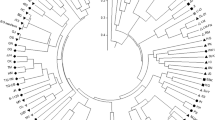Abstract
In citrus breeding and genetics, it is very important to distinguish between zygotic and nucellar seedlings in order to eliminate unwanted genotypes. Usually, isozyme marker shave been employed to determine the genetic origin of young plants. In this work we propose the use of SSR markers as an alternative methodology and compare them with isozymes in this kind of screenings. Two different populations were analysed: one derives from an interspecific cross and the other from selfing. We conclude that, in most cases, microsatellites are more efficient than isozymic markers to identify the sexual origin of citrus seedlings, given their higher level of polymorphism and the scarce number of polymorphic isozymes in some populations. We describe a quick and efficient methodology for SSR analysis, including a fast DNA extraction in microcentrifuge tubes, and visualization through silver staining, which eliminates the need for a labelling step.
Similar content being viewed by others
References
Anderson, C.M., W.S. Castle & G.A. Moore, 1991. Isozymic identification of zygotic seedlings in Swingle citrumelo Citrus paradisi x Poncirus trifoliata nursery and field populations. J Amer Soc Hort Sci 116: 322-236.
Ashari, S., D. Aspinall & M. Sedgley, 1988. Discrimination of zygotic and nucellar seedlings of five polyembryonic citrus rootstocks by isozyme analysis and seedling morphology. J Hort Sci 63: 695-703.
Asíns, M.J., R. Herrero & L. Navarro, 1995. Factors affecting three isozyme-gene expression. Theor Appl Genet 90: 892-898.
Asíns, M.J., P.F. Mestre, R. Herrero, L. Navarro & E.A. Carbonell, 1998. Molecular markers: a continuously growing biotechnology area to help citrus improvement. Fruits 53: 293-302.
Beidler, L.L., P.R. Hilliard & R.L. Rill, 1982. Ultrasensitive staining of nucleic acids with silver. Anal Biochem 126: 374-380.
Cameron, J.W., 1979. Sexual and nucellar embriony in F1 hybrids and advanced crosses of Citrus and Poncirus. J Am Soc Hort Sci 104: 408-410.
Cameron, J.W. & H.B. Frost, 1968. Genetics and nucellar embriony. In: W. Reuther, H.J. Webber & L.D. Batchelor (Eds.), The Citrus Industry. Vol II, pp. 327-371. University of California, Berkeley.
Cameron, J.W. & R.K. Soost, 1969. Citrus. In: F.D. Ferweda & F. de Witt (Eds.), Outlines of Perennial Crop Breeding in the Tropics. pp. 129-162. Wageningen, H. Veenman & Zonen.
Frost, H.B., 1943. Genetics and breeding. In: H.J. Webber & L.D. Batchelor (Eds.), The Citrus Industry. Vol. I, pp. 817-913. Univ California Press, Berkeley, Los Angeles.
Herrero, R., M.J. Asíns, E.A. Carbonell & L. Navarro, 1996. Genetic diversity in the orange subfamily Aurantioidae. I. Intraspecies and intragenus genetic variability. Theor Appl Genet 92: 599-609.
Iglesias, L., H. Lima & J.P. Simon, 1974. Isozyme identification of zygotic and nucellar seedlings in Citrus. J Hered 65: 81-84.
Karhu, A., P. Hulme, M. Karjalainen, P. Karvonen, K. Karkkainen, D. Neale & O. Savolainen, 1996. Do molecular markers reflect patterns of differentiation in adaptive traits of conifers? Theor Appl Genet 93: 215-221.
Khan, I.A. & M.L. Roose, 1988. Frequency and characteristics of nucellar and zygotic seedlings in three cultivars of trifoliate orange. J Am Soc Hort Sci 113: 105-110.
Kijas, J.M.H., M.R. Thomas, J.C.S. Fowler & M.L. Roose, 1997. Integration of trinucleotide microsatellites into a linkage map of Citrus. Theor Appl Genet 94: 701-706.
Litt, M. & J.A. Luty, 1989. A hypervariable microsatellite revealed by in vitro amplification of a dinucleotide repeat within the cardiac muscle actin gene. Am J Hum Genet 44: 397-401.
Mestre, P.F., M.J. Asíns, J.A. Pina, E.A. Carbonell & L. Navarro, 1997. Molecular markers flanking citrus tristeza virus resistance gene from Poncirus trifoliata (L.) Raf. Theor Appl Genet 94: 458-464.
Moore, G.A. & W.S. Castle, 1988. Morphology and isozymic analysis of open-pollinated Citrus rootstock populations. J Hered 799: 59-63.
Morgante, M. & A.M. Olivieri, 1993. PCR-amplified microsatellite as markers in plant genetics. The Plant J 3: 175-182.
Mullis, K., S. Fallona, S. Schraf, R. Saiki, G. Horn & H. Erlich, 1986. Specific enzymatic amplification of DNA in vitro: the polymerase chain reaction. Cold Spring Harbor Symp. Quant Biol 51: 263-273.
Orford, S.J., N.S. Scott & J.N. Timmis, 1995. A hypervariable middle repetitive DNA sequence from citrus. Theor Appl Genet 91: 1248-1252.
Raybould, A.F., R.J. Mogg, C. Aldam, C.J. Gilddon, R.S. Thorpe & R.T. Clarke, 1998. The genetic structure of sea beat (Beta vulgaris ssp. maritima) populations. III. Detection of isolation by distance at microsatellite loci. Heredity 80: 127-132.
Roose, M.L. & S.N. Traugh, 1988. Identification and performance of citrus trees on nucellar and zygotic rootstocks. J Am Soc Hort Sci 113: 100-105.
Russell, J.R., J.D. Fuller, M. Macaulay, B.G. Hatz, A. Jahoor, W. Powell & R. Waugh, 1997. Direct comparison of levels of genetic variation among barley accessions detected by RFLPs, AFLPs, SSRs and RAPDs. Theor Appl Genet 95: 714-722.
Spiegel-Roy, P., A. Bardi & A. Shani, 1977. Peroxidase isozymes as a tool for early separation of nucellar and zygotic Citrus seedlings. Proc Int Soc Citriculture 2: 619-624.
Tautz, D., 1989. Hypervariability of simples sequences as a general source for polymorphic DNA markers. Nucl Acid Res 17: 6463-6471.
Torres, A.M., R.K. Soost & V. Diedenhofen, 1978. Leaf isozymes as genetic markers in citrus. Amer J Bot 65: 869-881.
Torres, A.M., R.K. Soost & T. Mau-Lastovicka, 1982. Citrus isozymes. Genetics and distinguishing nucellar from zygotic seedlings. J Hered 73: 335-339.
Webber, H.J., 1932. Variation in citrus seedlings and their relation to rootstock selection. Hilgardia 7: 1-79.
Weber, J. & P.E. May, 1989. Abundantt class of human DNA polymorphisms which can be typed using the Polymerase Chain Reaction. Am J Hum Genet 44: 388-396.
White, G. & W. Powell, 1997. Isolation and characterisation of microsatellite loci in Swietenia humilis (Meliaceae): an endangered tropical hardwood species. Molec Ecology 6: 851-860.
Xiang, C. & M.L. Roose, 1988. Frequency and characteristics of nucellar and zygotic seedlings in 12 citrus rootstocks. Sci Hort 37: 47-59.
Author information
Authors and Affiliations
Rights and permissions
About this article
Cite this article
Ruiz, C., Paz Breto, M. & Asíns, M. A quick methodology to identify sexual seedlings in citrus breeding programs using SSR markers. Euphytica 112, 89–94 (2000). https://doi.org/10.1023/A:1003992719598
Issue Date:
DOI: https://doi.org/10.1023/A:1003992719598




